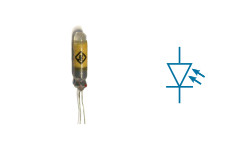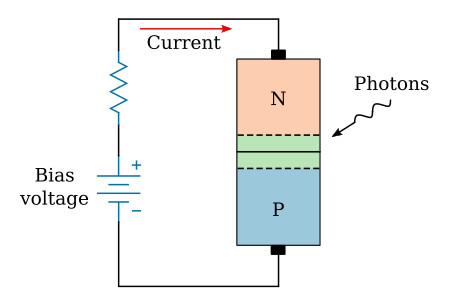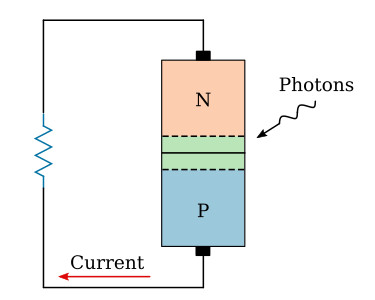Home > Textbooks > Basic Electronics > Transducers > Photodiodes >
Transducers
Photodiodes
The photodiode is a light-actuated device. In the ordinary diode, the current which flows under reverse-bias condition is due in large part to the thermally generated electron-hole pairs in the depletion layer. Light is basically the same physical manifestation as heat, but occupies a higher frequency band in the electromagnetic spectrum. Both heat and light manifest corpuscular as well as wave characteristics and can thereby be thought of as traversing space and materials in clusters of discrete wavetrains or packages of energy known as photons.
Photodiodes are designed so that optical energy (photons) incident on the active area produces a current. The particular properties of the photodiode are determined by the materials used and the layering of the materials within the device. Silicon, gallium arsenide, germanium, and indium phosphide are the common semiconductor materials used to produce photodiodes.
The figure below shows a photodiode with its schematic symbol. The arrows pointing toward the symbol indicate that light is required for operation of the device. Switching the light source on or off changes the conduction level of the photodiode. Varying the light intensity controls the amount of conduction. Because photodiodes respond quickly to changes in light intensity, they are extremely useful in many digital applications such as computer card readers and photographic light meters. They are also used in some types of optical scanning equipment.

Reverse Bias
The photodiode is usually operated with reverse-bias (photoconductive mode). In total darkness, it has a relatively high resistance and therefore conducts little current. If the junction region of a photodiode is exposed, light photons will impinge on the atoms in the semiconductor material. The impact energy will be sufficient to dislodge some outer-orbit electrons associated in the covalent bond which unites the atoms in the crystal-lattice structure. The dislodged electrons become mobile current carriers and simultaneously produce holes which likewise behave as mobile current carriers. These free electrons and holes are swept out of the junction region by the electric field produced by the bias battery and give rise to current in the external circuit (see the figure below).

Zero Bias
Photodiodes can produce a voltage when light is applied. Because of this, they require no external power; actually, they convert light energy into electrical energy (photovoltaic mode). The resultant action is basically the same as with the reverse bias. Electron-hole pairs are generated which upset the electrical equilibrium of the junction, thereby producing a current in the external circuit.







